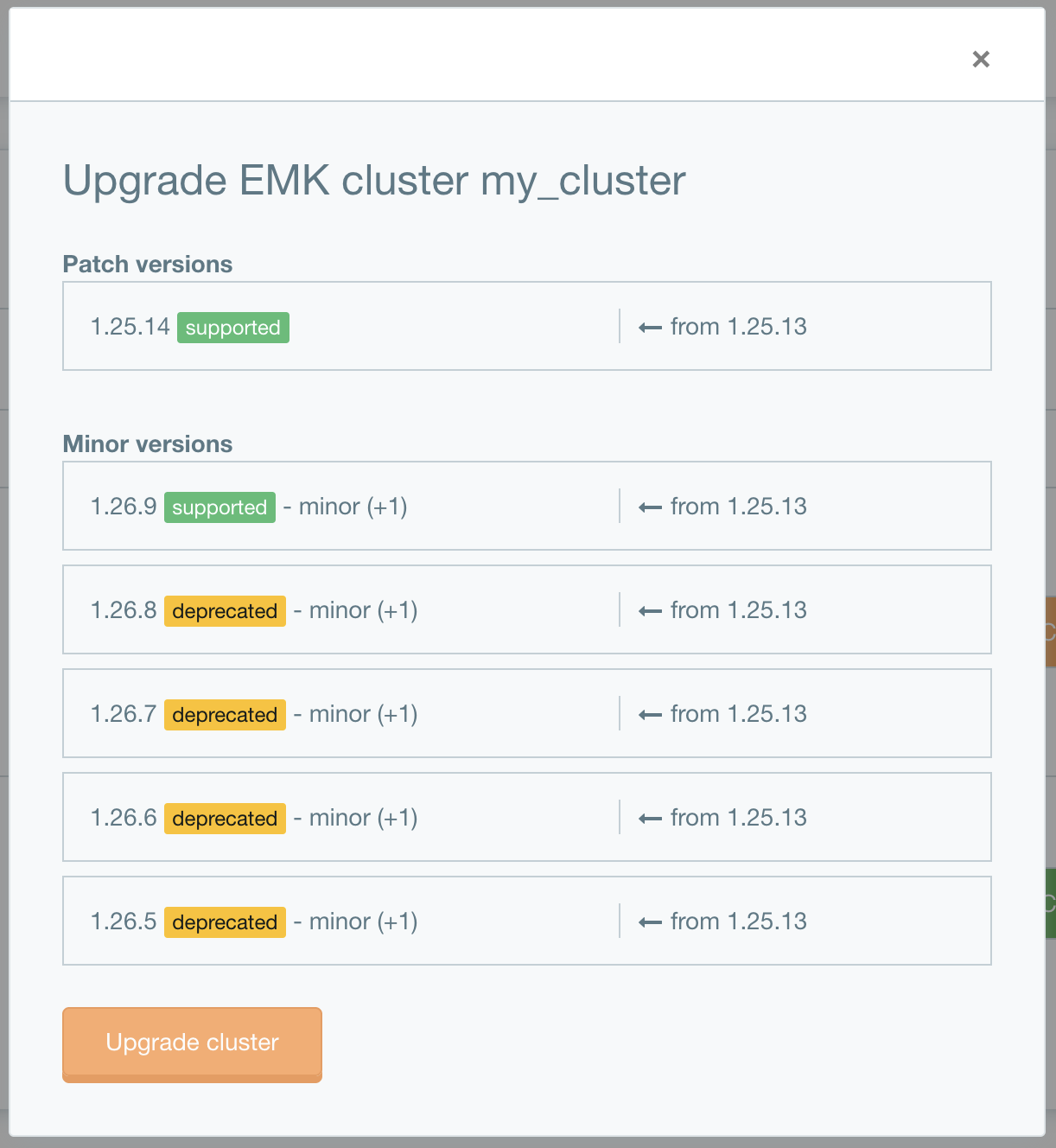EMK - Upgrade a Kubernetes cluster
Estimated time to read: 4 minutes
In this tutorial you learn how to upgrade your Kubernetes cluster to a higher version through the GUI, kubectl or Terraform.
Upgrading a cluster has some restrictions:
- Patch versions can be upgrade directly to the highest patch version.
- Minor versions can only be upgraded one minor at a time.
When the Kubernetes patch version is updated, the upgrade occurs in-place. This means that the worker nodes of the shoot remain unaffected, and only the kubelet process restarts with the new Kubernetes version binary. The same process applies for any configuration changes to the kubelet.
However, if the Kubernetes minor version is updated, the upgrade is carried out through a "rolling update" approach, akin to how pods are updated in Kubernetes (when managed by a Deployment). During this process, new worker nodes are created and old ones are then terminated. The existing workload is gracefully drained and evicted from the old worker nodes to the new ones, adhering to any configured PodDisruptionBudgets.
Upgrading an EMK Cluster is straightforward.
Navigate to the EMK Cluster overview in the Fuga dashboard
In this cluster overview example, there is one cluster displayed. A cluster can have different views around the version number:
| View | Description |
|---|---|
| Green | current highest minor and patch version |
| Yellow and "^" | patch version upgrade is available |
| Yellow and "^^" | minor version upgrade is available |
- Green color: the current highest minor and patch version.
- Orange and "^":
Clicking on the version or the "..." and then "upgrade cluster" will give the option to upgrade your cluster to a higher kubernetes version.
Danger
Make sure your workload can run on the next version of Kubernetes!
Select the version to upgrade to and click on Upgrade cluster.
Requirements:
- Kubectl, installation instructions can be found here.
- Service Account (SA), how to get one; See here.
First list your clusters.
% export KUBECONFIG=emk-sa-kubeconfig.yaml
% kubectl get shoots
NAME K8S VERSION HIBERNATION LAST OPERATION STATUS AGE
my-cluster 1.28.8 Awake Reconcile Succeeded (100%) healthy 42d
Then list all the currently available kubernetes versions with:
or use:❯ kubectl get cloudprofile fugacloud --output 'jsonpath={.spec.kubernetes.versions}' | jq .
.....
- classification: deprecated
version: 1.28.8
- classification: supported
version: 1.28.9
This will output in a readable format the currenct kubernetes versions. In the previous list of shoots it is possible to see our cluster is at 1.28.8. So it is possible to upgrade it to 1.28.9.
It is possible to do that with the following command:
kubectl patch shoot my-cluster -p '{"spec":{"kubernetes":{"version": "1.28.9"}}}'
shoot.core.gardener.cloud/my-cluster patched
While your cluster is upgraded, you can check the status of the upgrade process by listing your clusters:
Requirements:
- Terraform, installation instructions can be found here.
- Service Account (SA), how to get one; See here.
This Terraform guide assumes the creation of clusters through our creation tutorial; see here.
To upgrade the cluster it is required to set the value spec.kubernetes.version to a higher kubernetes version in the cluster.yaml configuration:
Run terraform plan and terraform apply.
❯ terraform apply
kubectl_manifest.my_first_cluster: Refreshing state... [id=/apis/core.gardener.cloud/v1beta1/namespaces/ garden-thomas/shoots/my-cluster]
Terraform used the selected providers to generate the following execution plan. Resource actions are indicated with the following symbols:
~ update in-place
Terraform will perform the following actions:
# kubectl_manifest.my_first_cluster will be updated in-place
~ resource "kubectl_manifest" "my_first_cluster" {
id = "/apis/core.gardener.cloud/v1beta1/namespaces/garden-thomas/shoots/my-cluster"
name = "my-cluster"
~ yaml_body = (sensitive value)
~ yaml_body_parsed = <<-EOT
apiVersion: core.gardener.cloud/v1beta1
kind: Shoot
spec:
+ kubernetes:
+ version: "1.28.9"
name: my-cluster
namespace: garden-thomas
spec:
.............
EOT
# (13 unchanged attributes hidden)
}
Plan: 0 to add, 1 to change, 0 to destroy.
Do you want to perform these actions?
Terraform will perform the actions described above.
Only 'yes' will be accepted to approve.
Enter a value: yes
kubectl_manifest.my_first_cluster: Modifying... [id=/apis/core.gardener.cloud/v1beta1/namespaces/ garden-thomas/shoots/my-cluster]
kubectl_manifest.my_first_cluster: Modifications complete after 0s [id=/apis/core.gardener.cloud/v1beta1/ namespaces/garden-thomas/shoots/my-cluster]
Apply complete! Resources: 0 added, 1 changed, 0 destroyed.
The cluster will now be upgraded, the process for upgrading can take some time.

